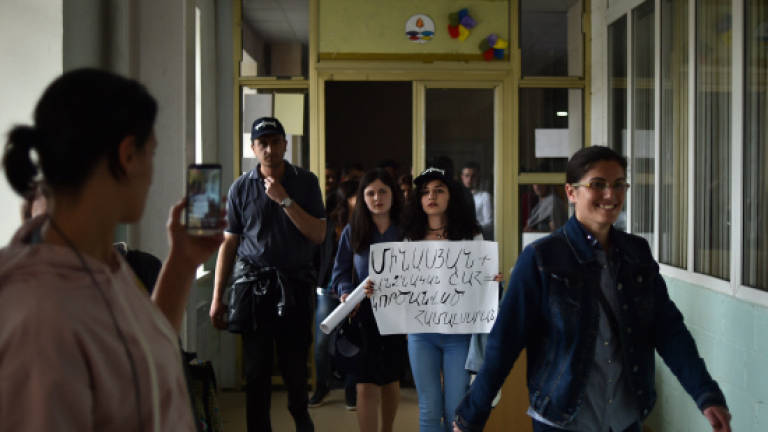Crisis in Armenia

YEREVAN: Armenia's parliament is set to meet on Tuesday to elect a new prime minister following a political crisis that erupted on April 11.
Here is a timeline of events which forced veteran leader Serzh Sarkisian to step down after sweeping protests.
President seeks PM post
On April 11, Serzh Sarkisian's ruling Republican Party announces his nomination for the premiership at the end of his second and final term as president.
Constitutional amendments approved in 2015 strengthened the role of the prime minister, turning the poor Russia-allied country into a parliamentary republic.
Mass demonstrations
From April 13, thousands of people protest in the capital Yerevan against what they view as a power grab by Sarkisian.
On April 16, several dozen people are injured in clashes with the police as protestors, led by opposition leader and MP Nikol Pashinyan, try to approach parliament.
Sarkisian elected
On April 17, Armenia's parliament elects Sarkisian, 63, as prime minister.
About 40,000 people gather in Yerevan's Republic Square to protest, chanting "Armenia without Serzh!".
Protests continue over the following days.
Opposition leader arrested
On April 22, talks between Pashinyan, 42, and Sarkisian last only minutes with the new prime minister storming out after the opposition leader demands his resignation.
Pashinyan and two other opposition deputies are detained shortly afterwards.
Prime minister quits
On April 23, Pashinyan is freed and Sarkisian resigns as prime minister, saying the opposition leader was right and "I was wrong".
Armenians cheer and set off fireworks.
"You have won, the proud citizens of Armenia!" Pashinyan writes on Facebook.
The following day he says he is "ready to lead the country" and calls for early legislative elections.
Russia as mediator
On April 26, parliament announces a new prime minister will be elected at an extraordinary sitting on May 1.
Armenia turns to Russia for mediation with senior officials holding talks with President Vladimir Putin and other top members of government.
Russia, which has a military base in Armenia, says the settlement of the crisis should be "solely within the legal framework".
Pashinyan sole candidate
On April 27, authorities refuse to negotiate with Pashinyan, accusing him of dictating his "agenda" as mass rallies are held in his support.
Tens of thousands of Pashinyan supporters gather again in Yerevan over the next days in a massive show of force ahead of the parliamentary vote they hope will help propel him to power.
But on May 1 parliament rejects Pashinyan's candidacy: he receives only 45 of the necessary 53 votes.
Pashinyan then calls on protesters to block key transport links in what he calls a "general strike".
Prime minister's election
The next day tens of thousands of people converge on Yerevan, paralysing the capital, blocking roads and trains.
Parliament announces it will convene for an extraordinary session on May 8 to elect a prime minister.
If lawmakers fail to elect a prime minister for a second time, the legislature will be dissolved and early elections called.
That evening Pashinyan calls for an end to the wave of protests, saying he had secured the support for his bid from all four parties in parliament. — AFP